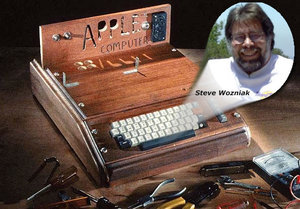One of my great mysteries of the last few years, the failure of Always-On, has been solved.
Always-On, in case you have forgotten, is the idea of using an 802.11 router as an application platform, building solutions for medical monitoring, home automation and home inventory using sensors and RFID tags, solutions that live in the air.
Harald Welte writes that hardware makers do not respect Free and Open Source Software, which would jump-start this process of innovation. When they use it in their designs, they use crap. As a result there is nothing to build a project around.
But why do they use crap? Why do they insist on only using proprietary code in hardware?
I submit the problem is China. China makes our hardware. China and Taiwan, between them, have a near-monopoly on hardware production. Taiwan has higher costs, but they can turn designs around faster, so you take your pick.
What this means is that every new hardware design must be exported, then imported. The iPod is exported, then imported. So is your PC. So is your mobile phone. So is your game player. The Chinese stranglehold on the market is so tight that western production no longer exists.
In order to make this work, however, this exporting and importing, you have to work the mass market. You have to deliver mass quantities, literally millions of units at a time. And the only way you can do that is by having a throat you can choke when things go wrong. That guy has to be big enough to have a chokeable throat. U.S. chipmakers are large enough for this, but they, too, make their stuff overseas. And no one gets respect unless they’re big.
In this kind of market true entrepreneurship is impossible. The advantages Americans have traditionally had — the ability to "think out of the box," the ability to "start small and grow," they become irrelevant. It’s like having a ladder with the bottom rungs missing. Only someone who can take that first step (and it’s a doozy) can get on.
Conservatives will say the market has failed. Liberals will say our industrial policy (and it always exists, regardless of your rhetoric) has failed. Historians might even blame Moore’s Law, specifically Moore’s Second Law, which demands that more complex designs scale exponentially in order to become economic.
I don’t care who has failed.

wanted to take today’s chips and make something with them, something
that had never existed before. Imagine these folks were getting
together in the Valley and meeting every month, as was done back in the day.
Could they come up with anything? Are the pieces there to support a
21st century Heathkit, a 21st century Byte Magazine, a 21st century
start-up called Apple?
No!
That’s what we have to change. We have to get the bottom rungs of the ladder back if America is to compete in technology again.
Without those bottom rungs, we’re toast. We’re slaves to China
tomorrow, as we’re slaves to China today. And I, for one, do not
welcome our new Chinese overlords. They’re slow, they’re clumsy, and
they’re Clueless.











You’re right that China is a big part of the problem, but it is not in the way you think. The problem is that the Chinese make stuff that is cheaper than anything that can be made here. This cheaper stuff is often far inferior, but the price is just so appealing. It is IT as fast food. You know it’s crap, but it is so easy to get and the price is so appealing. If you spent some serious thought on it, wouldn’t you rather spend $100 on a router that is easy to configure, doesn’t need 3 generations of firmware upgrades before it works, and is likely to last 5 years, than a $50 one that is none of the above? Of course you would, but who really has time to top and think — especially when all the in-store advertising is pointing you to the cheap product. Anyway, since the cheap thing is the one that sells, there often isn’t even premium competition. In most cases, the $100 router doesn’t have better hardware or software, it just has a “better” brand name. It is not until you get to the $1,000+ IT products that you can get beyond the box of crap with minimal software but really great price stuff.
I have no idea what the solution to this is. After all, no one seems to have solved the fast food dilema — which has a much higher public profile. In the end, these may be largely unsolvable problems.
You’re right that China is a big part of the problem, but it is not in the way you think. The problem is that the Chinese make stuff that is cheaper than anything that can be made here. This cheaper stuff is often far inferior, but the price is just so appealing. It is IT as fast food. You know it’s crap, but it is so easy to get and the price is so appealing. If you spent some serious thought on it, wouldn’t you rather spend $100 on a router that is easy to configure, doesn’t need 3 generations of firmware upgrades before it works, and is likely to last 5 years, than a $50 one that is none of the above? Of course you would, but who really has time to top and think — especially when all the in-store advertising is pointing you to the cheap product. Anyway, since the cheap thing is the one that sells, there often isn’t even premium competition. In most cases, the $100 router doesn’t have better hardware or software, it just has a “better” brand name. It is not until you get to the $1,000+ IT products that you can get beyond the box of crap with minimal software but really great price stuff.
I have no idea what the solution to this is. After all, no one seems to have solved the fast food dilema — which has a much higher public profile. In the end, these may be largely unsolvable problems.
Wow, I think that was the original case against open source circa 1995. Too funny.
Wow, I think that was the original case against open source circa 1995. Too funny.
What are you talking about Brad? Some of the best high end IT gear is based on source components. Open source is also the solution to products shipping with decent hardware and crappy software — if the software is open source it can be modified by the user community or 3rd parties. You complain about people being cheerleaders and then post comments that are mere heckling. You often have a real point to make, so why not just make it rather than just throwing out vague negative comments?
What are you talking about Brad? Some of the best high end IT gear is based on source components. Open source is also the solution to products shipping with decent hardware and crappy software — if the software is open source it can be modified by the user community or 3rd parties. You complain about people being cheerleaders and then post comments that are mere heckling. You often have a real point to make, so why not just make it rather than just throwing out vague negative comments?